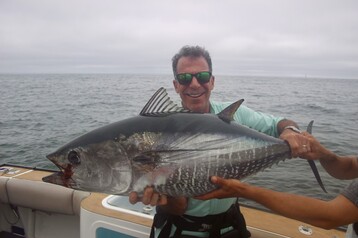Current Waters: Nantucket Fishing Report
Captain Carl Bois •


We’re in the thick of summer this part of July. The fishing is still great. Striped bass fishing is still going strong. So we’re having fun with them. The water definitely cooled down a bit with all the recent fog which helps keep it going.
No big changes with bluefish.
We had a unique catch a few days ago while tuna fishing. We caught a bonito on a spreader bar offshore. That’s a new one for us that far out. As usual, I was too busy to take a photo of it. As Captain Pete Kaizer would say, “If there isn’t a photo, it never happened.”
For fluke and other bottom fish, we’re getting them, but I certainly hope it continues to improve. It’s hit or miss right now, but we are getting some.
You may have heard that the offshore tuna fishing has been great. There have been some fantastic days for tuna. Other days, you have to work for them, as it should be. It’s a bit of a ride and the tuna are moving around a lot. We stay in touch with our network of trustworthy reports. Either way, it’s a great time of year to be on the water. Pelagic birds, dolphins, and whales – you never know what you’re going to see.
With all of the excitement of sharks lately, everyone wants to have the great white experience and/or photo. We do get a sighting of a great whites sometimes, but there are a lot of other shark species cruising around Great Point as well. One of the larger ones we encounter pretty regularly is the dusky shark.
The dusky shark (Carcharhinus obscurus) is one of our larger sharks which can reach up to 12 feet or so at maturity. This large shark species has a broad, rounded snout, and triangular saw-edged upper teeth. They have a small flap of skin on the outer side of each nostril. Their curved pectoral fins are moderate in size, and they have an interdorsal ridge on their backs. The dusky is blue-gray to dark-gray on the dorsal side, white on the ventral side. They are sometimes difficult to distinguish from large sandbar sharks. Sandbar sharks have higher first dorsal fins originating farther forward. Sandbar sharks also don’t get as big as duskies.
Dusky sharks are primarily found in neotropical waters. We’re basically at the northern range limit of the species here on Nantucket. This is a highly migratory species generally found in coastal and offshore waters at depths between 200-400m. They undertake lengthy migrations up and down the coast in summer and fall.
This time of year, however, duskies migrate to coastlines where they overlap with other shark species usually found inshore. Like many migratory species, they are here during the warmer months and move back towards the equator as waters cool. Right now, they’re here for the food.
As generalist apex predators, duskies feed on bony fish, other sharks, skates, rays, cephalopods, crustaceans, and occasionally on mammalian carrion, and even garbage. In the northwestern Atlantic, around 60% of the dusky shark's diet consists of bony fishes, from over ten families, with bluefish and summer flounder being especially important. A good indicator of why they hang out at Great Point.
Dusky sharks are a protected fish on the prohibited harvest list. If caught, they should be immediately returned to the water “in such a manner as to ensure maximum probability of survival.” Actually, all sharks with the interdorsal ridge are protected (see the list at the link above).
Duskies are not known to be aggressive (unless provoked). However, their behavior makes them vulnerable. They are among the slowest-growing, latest-maturing of large sharks, making them more vulnerable to overfishing than some other sharks. Their very low reproductive rate also contributes. Full-grown dusky sharks have no significant natural predators, with overfishing being the primary threat to the species.
Research by Dr. Caroline Collatos on sandbar sharks, which we highlighted previously, will also help us learn more about the dusky sharks around Nantucket shores.
Keep in mind that if you see a shark fin or a beach is closed for a shark sighting, it’s more likely to be one of the sandbar or dusky shark species, not known to be aggressive. Still, take precautions in the water around seals, but Great Whites are less of a problem than is sometimes suggested.
Thanks to all those who commented on the mole crab post from last week. We had a lot of comments with similar observations of mole crabs - commonly called sand fleas - missing from various beaches where they’ve been prevalent in the past. One question that was brought up by multiple readers was if there was any connection with the windfarm blade failure last summer. It’s only speculation at this point, but mole crabs feed on tiny particles in the water, and it is known that microplastics can affect populations. So what about fiberglass debris? We’ll keep an eye out for mole crabs in the coming months, but keep us posted about what you find!
Until next tide...